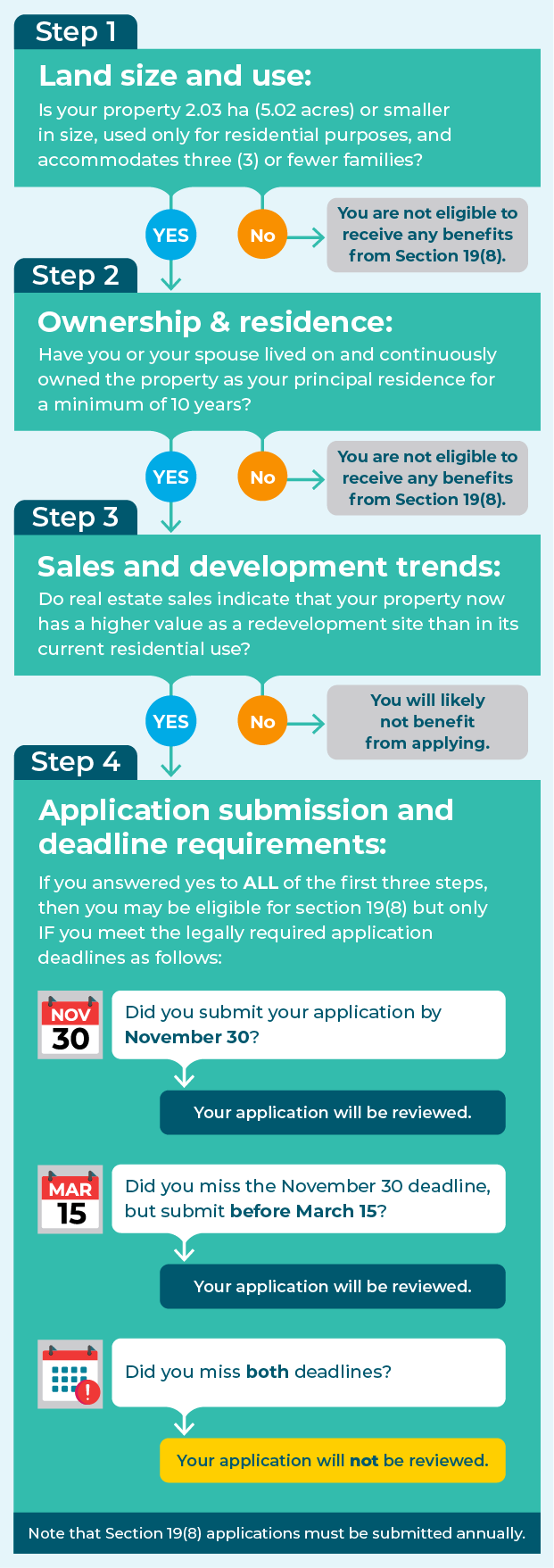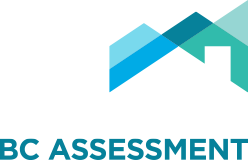Section 19(8) of the Assessment Act allows certain residential land to be assessed at less than market value where the owner qualifies and provided the property has potential for development for a more valuable use than its current use.
If your property qualifies for assessment relief under section 19(8) based on the application you have submitted, it will be valued based on its current use. Your property’s assessment is re-evaluated each year and may change if the market values of the comparable properties change.
Who is section 19(8) for?
Typically, section 19(8) is for long-term property owners living in communities or neighbourhoods where land use is changing and which may result in higher property assessment values. For example, a single-family home in an area zoned for multi-family high-rise buildings might qualify for a section 19(8) assessment application if the homeowner meets
ALL of the eligibility requirements.
Section 19(8) application form
The
Section 19(8) application form (PDF) can only be completed and submitted
AFTER you have determined your eligibility.
Eligibility for section 19(8) application
Before requesting section 19(8) be applied to your property’s assessment value, you need to first determine your property’s eligibility.
Following these simple step-by-step questions will help you determine whether your property is eligible or not. For more detail on each section, select from the following eligibility criteria below:

Section 19(8) applies to land that is 2.03 hectares (approximately 5 acres) or smaller, with existing home(s) for residential purposes. The residential status cannot be used to accommodate more than three families.
This residential land must have the potential for development so that the property’s market value in another use is higher than the property’s existing residential value. Examples include:
- a house located on land that is zoned for, or that has been rezoned for, commercial use (e.g., allowing for a store or office building);
- a house located on a four-acre property which could be developed into multiple one-quarter-acre lots; and
- a single-family house in an area zoned for multi-family homes (e.g. a small home in downtown Vancouver).
Residential property owners who have owned and occupied the property on a continuous and ongoing basis for at least 10 years may be eligible.
The owner must have:
- owned the property continuously for the past ten years; and
- occupied the property as their principal residence continuously for 10 years
The 10 years must be as of October 31 of the year before the tax year for which the relief would be applicable. Additional qualifying criteria may have to be met.
How property transfers affect eligibility for section 19(8)
A property can be transferred to a spouse and still meet the definition of continuous ownership. When a property is transferred to a family member other than a spouse, the definition of continuous ownership is no longer met and the property is no longer eligible for assessment relief under Section 19(8).1
Subdividing land
When a property is subdivided, its status as eligible residential property under Section 19(8) can change. In some cases, the owner could still qualify because they remained living on part of the land.
For example, Magnus Smith v. Area 13 (1996)2, the owner successfully argued that despite the subdivision, he continued to live on part of the original property and therefore should still qualify for Section 19(8) relief.
Are recent sales showing that your property is worth more as a development site (Highest and Best Use) than as its current use (Actual Use) as a house? If so, and if you meet
ALL the other eligibility criteria, you could benefit from being assessed under Section 19(8).
If not, it's a good idea to keep an eye on sales and development trends in your area in the coming years to see if conditions change.
Understanding actual use compared to highest & best use
Actual use refers to the property's current use. Under Section 19(8), if a property qualifies as eligible, it is assessed based on its use as a single-family dwelling Actual use does not include other potential uses allowed by zoning or market trends.3
Highest and best use (HBU) considers the most profitable legal use of the property, which could include redevelopment into multi-family units, commercial properties, or other potential uses as determined by the market. When a property is assessed based on its highest and best use, this means the property is valued as if it could be used for a more profitable purpose, like a commercial or high-rise development, even if the current owner is still using it as a home.4
Typical applications:
To qualify for section 19(8), a property owner must submit a completed
application form each year to receive the benefit in the following assessment / taxation year. The application deadline is November 30.
Applying through the Property Assessment Review Panel process:
If you cannot, or did not, submit your application by November 30, please
contact your local BC Assessment area office, as applications received between November 30 and the following March 15 may qualify for processing through the assessment review process.
Note that there is NO legal authority to grant application deadline extensions.5
Access the
section 19(8) application form to make your submission.
More information
Section 19(8) application forms (PDF)and additional information on the special property assessment treatment provided under section 19(8) may be obtained by
contacting BC Assessment.
Disclaimer: Where information presented is different from legislation, legislation shall prevail.
1.
Property transfers stated cases:
Naudi, Francois B. v. Area 10 (2018, October 2, 2018) /
Fornier-Hanlon, Jeremy and Salome v. Area 08 (2016, October 26, 2016)
2.
Property subdivisions stated cases:
Magnus Smith v. Area 13 (1996, SC 369, BCCA – November 26, 1996)
3.
Actual Use stated case: in
Leung v. Area 11 (2010), the court upheld the use of actual use valuation under Section 19(8) for a single-family home in a high-density development area, which prevented the property from being assessed based on its redevelopment potential.
4.
Highest & Best Use stated case: This was seen in
Shirlaghab v. Area 10 (2021), where the property was assessed based on its redevelopment potential, despite the owner’s intention to continue living in the home.
5.
APPLICATION DEADLINES: Some homeowners fail to submit their applications for assessment relief on time, often citing personal difficulties, confusion about the process, or a lack of awareness. However, the Assessment Act is clear regarding deadlines to submit an application, and there is no legal authority to grant extensions beyond March 15.
Tomasic v. Area 10 (1997, September 26, 1997) /
Huang, Bill C v. Area 14 (2006, October 3, 2006) If an owner that previously benefited from the relief does not apply within the time required by the Assessment Act in any given year, the owner may see an increase in assessed value and taxes the following year.

